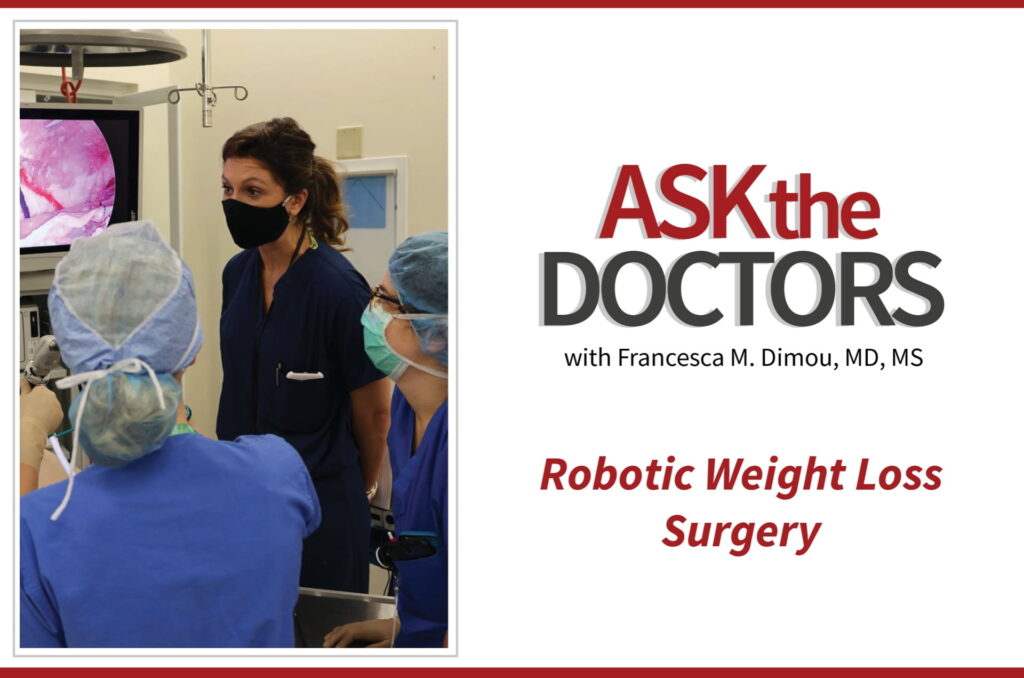Obesity is a common, serious disease that affects more than one third of adults and one in five children in the United States. Being overweight or obese increases a person’s risk of type 2 diabetes, heart disease, stroke, fatty liver disease, kidney disease and other health issues. Weight loss surgery, also called bariatric surgery, is an effective tool to help people who are severely obese and have been unable to lose weight through diet or other traditional means.
Robotic surgery offers Washington University bariatric surgeons a new approach for safely and effectively performing weight loss procedures.
Francesca Dimou, MD, MS, a fellowship-trained minimally invasive and bariatric surgeon, answers some frequently asked questions about robotic weight loss surgery.
“With weight loss surgery, we are giving people an important tool to help them lose weight and change their lives,” Dimou says. “Robot-assisted surgery helps us provide that tool safely and effectively.”
Robotic Weight Loss Surgery: Frequently Asked Questions
What is robotic surgery?
Robotic surgery uses new technology to perform operations with smaller incisions. The surgeon sits at a console in the same room as the patient and controls the arms of the robot to perform the operation. The robot has 3D cameras that provide a very clear view for the surgeon. An expert team joins the surgeon and patient in the operating room to assist with the surgery.
“A lot of patients are surprised when they come into the robot room,” Dimou says. “Compared to other operating rooms, the robot room is very large, because we have the robot itself, the bed, multiple screens and the console where the surgeon sits. We have a whole team of experts there for you, from anesthesiology to nursing. I tell patients it’s almost like your own personal NASCAR pit crew.”
How long does robotic weight loss surgery take?
Washington University bariatric surgeons perform sleeve gastrectomy, gastric bypass and duodenal switch procedures robotically. Whether done with the robot or laparoscopically, the average times remain the same. The average time for a sleeve gastrectomy is approximately an hour and a half. Gastric bypass surgery takes between two to four hours.
How long a procedure takes depends on a number of factors, including the surgeon’s experience and the patient’s medical history. Originally, data suggested that robotic surgery might take longer, but more recent findings suggest that it depends on the surgeon’s level of experience with the robot.
Is robotic surgery safe?
“Robotic surgery is safe. The most important thing is that patients have good outcomes. We will not offer a procedure that is not safe,” Dimou assures.
Dimou suggests asking your surgeon about their experience with robotic surgery before the procedure. As an Advanced Gastrointestinal and Minimally Invasive Surgery Fellow at Weill Cornell Medicine, Dimou performed over 200 robotic cases in a year.
“You are your own biggest advocate,” Dimou says. “You need to know what sort of training your surgeon has had, and also what support system is available to you before, during and after surgery. It is completely appropriate for you to ask questions.”
What is the difference between robotic and laparoscopic surgery?
Both laparoscopic and robotic surgery are minimally invasive approaches. With each, the incisions are much smaller than with traditional open surgery. The outcomes for both are comparable, though the techniques are different.
In laparoscopic surgery, the surgeon creates several small incisions and places a laparoscope—a scope with a light and camera—through one of the incisions. This allows the surgeon to view the anatomy. The surgeon performs the operation working with long instruments placed through small tubes in the other incisions.
Similarly, robotic surgery uses small incisions and allows the surgeon to see the anatomy. The robot provides 3D visualization, improving the surgeon’s view and increasing depth perception. The robot also features wristed arms that can bend and move, and their instruments provide a broader range of motion than laparoscopic instruments. The robot enables the surgeon to sit at a console with controls within easy reach. This prevents physician arm or leg fatigue and offers more precise positioning during the one- to three-hour procedure. Using the robot also makes it easier for the surgeon to access parts of the body that can be difficult to reach in obese patients.
“When people ask me what option is best, I tell them that it depends,” Dimou says. “It’s not as simple as saying everyone gets robotic surgery, or everyone gets a sleeve gastrectomy. We tailor care to our patients to give them the right surgery.”
Why should I choose a Washington University bariatric surgeon?
The Washington University Weight Loss Surgery Program offers bariatric surgery as an option for people with severe obesity who are unable to maintain weight loss through lifestyle changes. Patients in the Weight Loss Surgery Program receive expert care from Washington University physicians in a program accredited by the MBSAQIP (Metabolic and Bariatric Surgery Accreditation and Quality Improvement Program). The program was recently recognized as a Blue Distinction Center for their expertise in delivering specialty care.
To book a consultation, please call 314.542.9378.
